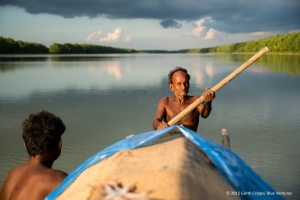Blog: Can science benefit both mud crabs and local fishers in the Sundarban?
Location: Bangladesh. 4th Jul 2016
Setting the Scene
Small-scale subsistence fishing of mud crabs in the Sundarban has turned into a fast-growing industry, thanks to flourishing international demand. The marginal fishermen who live in-and-around the Sundarban usually make 8- to 12-day fishing trips, during which they collect as many crabs as possible from the creeks of this mangrove forest. Before being exported, the live crabs change hands several times; some are sent to be fattened until they attain the desired weight, whilst others are exported directly from the natural forest to foreign markets.
Interestingly, this process is not as simple as it appears. The scenario on-the-ground has evolved alongside the gradual shift of demand and markets from local to international spheres. So, what are we actually missing?
A Burgeoning, Demand-Driven Market for Wild Mud Crabs
As the market for mud crabs grew, the promise of quick-and-easy money attracted both permanent and seasonal middle-men at all levels, resulting in an intricate, tangled web of a supply-chain. Whilst the profits derived from exports circulated amongst a greater number of actors, the profit margin per actor increased less than those climbing aboard the gravy train had expected. Later, old stakeholders and businessmen—with their influence and understanding of the mud crab market—started investing more, and taking up multiple roles in order to secure a larger share of the profits.
As a consequence, the market became complicated and competitive; this, along with a rising demand from consumers, led to significant pressure being exerted on the mud crabs of the Sundarban, a fact that went unregistered in this frenzied marked. Additionally, since no alternative forms of supply (e.g. mud crab culture) have yet been established, the market continues to depend on a constant supply of mud crabs from the serpentine creeks of the Sundarban.
Socio-Economic Equity and Perspectives
The booming mud crab industry undoubtedly employs and supports thousands of families along the south-west coast of Bangladesh. However, little has changed for the marginal fishermen who collect crabs directly from the forest. Researchers assert that the main factors behind this prevailing societal and financial injustice are the ignorance of fishermen regarding the price at international markets, and the informal money-lending system (which lacks the requisite paperwork and authority). The current lack of governance is highlighted when Laxmipod Mondol from Kolbari, involved with the mud crab fisheries for more than 16 years, reflects that “most of them (fishermen/crab collectors) have now turned opportunistic and cheater.” Mr. Mondol also adds that fishermen either take loans from middle-men or are given advances from them in return for an oral assurance that they (the fisherman) will sell all their catch to the creditor.
For full article, please visit the Save our Species blog website.

Fisherman in Sundarban, Bangladesh © © Garth Cripps/ Blue Ventures